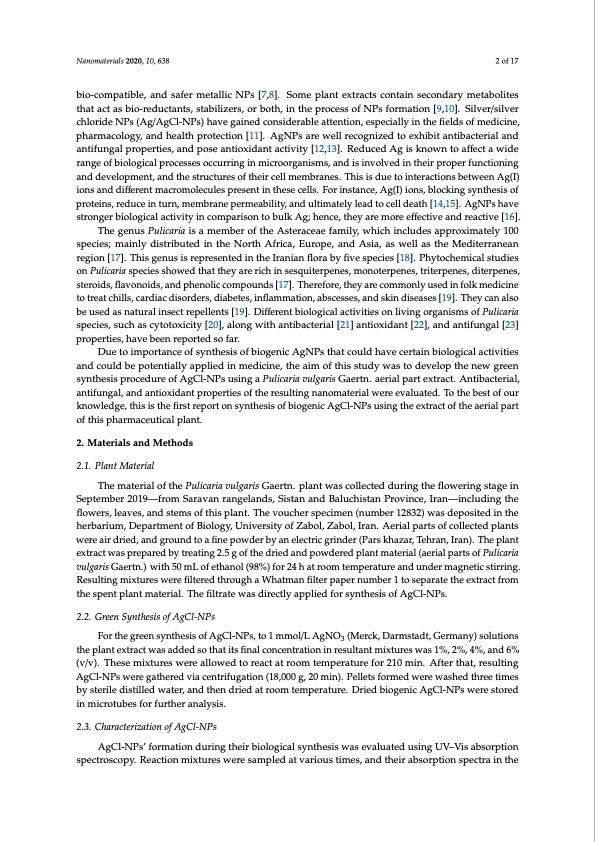
PDF Publication Title:
Text from PDF Page: 002
Nanomaterials 2020, 10, 638 2 of 17 bio-compatible, and safer metallic NPs [7,8]. Some plant extracts contain secondary metabolites that act as bio-reductants, stabilizers, or both, in the process of NPs formation [9,10]. Silver/silver chloride NPs (Ag/AgCl-NPs) have gained considerable attention, especially in the fields of medicine, pharmacology, and health protection [11]. AgNPs are well recognized to exhibit antibacterial and antifungal properties, and pose antioxidant activity [12,13]. Reduced Ag is known to affect a wide range of biological processes occurring in microorganisms, and is involved in their proper functioning and development, and the structures of their cell membranes. This is due to interactions between Ag(I) ions and different macromolecules present in these cells. For instance, Ag(I) ions, blocking synthesis of proteins, reduce in turn, membrane permeability, and ultimately lead to cell death [14,15]. AgNPs have stronger biological activity in comparison to bulk Ag; hence, they are more effective and reactive [16]. The genus Pulicaria is a member of the Asteraceae family, which includes approximately 100 species; mainly distributed in the North Africa, Europe, and Asia, as well as the Mediterranean region [17]. This genus is represented in the Iranian flora by five species [18]. Phytochemical studies on Pulicaria species showed that they are rich in sesquiterpenes, monoterpenes, triterpenes, diterpenes, steroids, flavonoids, and phenolic compounds [17]. Therefore, they are commonly used in folk medicine to treat chills, cardiac disorders, diabetes, inflammation, abscesses, and skin diseases [19]. They can also be used as natural insect repellents [19]. Different biological activities on living organisms of Pulicaria species, such as cytotoxicity [20], along with antibacterial [21] antioxidant [22], and antifungal [23] properties, have been reported so far. Due to importance of synthesis of biogenic AgNPs that could have certain biological activities and could be potentially applied in medicine, the aim of this study was to develop the new green synthesis procedure of AgCl-NPs using a Pulicaria vulgaris Gaertn. aerial part extract. Antibacterial, antifungal, and antioxidant properties of the resulting nanomaterial were evaluated. To the best of our knowledge, this is the first report on synthesis of biogenic AgCl-NPs using the extract of the aerial part of this pharmaceutical plant. 2. Materials and Methods 2.1. Plant Material The material of the Pulicaria vulgaris Gaertn. plant was collected during the flowering stage in September 2019—from Saravan rangelands, Sistan and Baluchistan Province, Iran—including the flowers, leaves, and stems of this plant. The voucher specimen (number 12832) was deposited in the herbarium, Department of Biology, University of Zabol, Zabol, Iran. Aerial parts of collected plants were air dried, and ground to a fine powder by an electric grinder (Pars khazar, Tehran, Iran). The plant extract was prepared by treating 2.5 g of the dried and powdered plant material (aerial parts of Pulicaria vulgaris Gaertn.) with 50 mL of ethanol (98%) for 24 h at room temperature and under magnetic stirring. Resulting mixtures were filtered through a Whatman filter paper number 1 to separate the extract from the spent plant material. The filtrate was directly applied for synthesis of AgCl-NPs. 2.2. Green Synthesis of AgCl-NPs For the green synthesis of AgCl-NPs, to 1 mmol/L AgNO3 (Merck, Darmstadt, Germany) solutions the plant extract was added so that its final concentration in resultant mixtures was 1%, 2%, 4%, and 6% (v/v). These mixtures were allowed to react at room temperature for 210 min. After that, resulting AgCl-NPs were gathered via centrifugation (18,000 g, 20 min). Pellets formed were washed three times by sterile distilled water, and then dried at room temperature. Dried biogenic AgCl-NPs were stored in microtubes for further analysis. 2.3. Characterization of AgCl-NPs AgCl-NPs’ formation during their biological synthesis was evaluated using UV–Vis absorption spectroscopy. Reaction mixtures were sampled at various times, and their absorption spectra in thePDF Image | Synthesis of Biogenic Silver Nanoparticles Aerial Part Extract

PDF Search Title:
Synthesis of Biogenic Silver Nanoparticles Aerial Part ExtractOriginal File Name Searched:
nanomaterials-10-00638.pdfDIY PDF Search: Google It | Yahoo | Bing
Turbine and System Plans CAD CAM: Special for this month, any plans are $10,000 for complete Cad/Cam blueprints. License is for one build. Try before you buy a production license. More Info
Waste Heat Power Technology: Organic Rankine Cycle uses waste heat to make electricity, shaft horsepower and cooling. More Info
All Turbine and System Products: Infinity Turbine ORD systems, turbine generator sets, build plans and more to use your waste heat from 30C to 100C. More Info
CO2 Phase Change Demonstrator: CO2 goes supercritical at 30 C. This is a experimental platform which you can use to demonstrate phase change with low heat. Includes integration area for small CO2 turbine, static generator, and more. This can also be used for a GTL Gas to Liquids experimental platform. More Info
Introducing the Infinity Turbine Products Infinity Turbine develops and builds systems for making power from waste heat. It also is working on innovative strategies for storing, making, and deploying energy. More Info
Need Strategy? Use our Consulting and analyst services Infinity Turbine LLC is pleased to announce its consulting and analyst services. We have worked in the renewable energy industry as a researcher, developing sales and markets, along with may inventions and innovations. More Info
Made in USA with Global Energy Millennial Web Engine These pages were made with the Global Energy Web PDF Engine using Filemaker (Claris) software.
Infinity Turbine Developing Spinning Disc Reactor SDR or Spinning Disc Reactors reduce processing time for liquid production of Silver Nanoparticles.
| CONTACT TEL: 608-238-6001 Email: greg@infinityturbine.com | RSS | AMP |